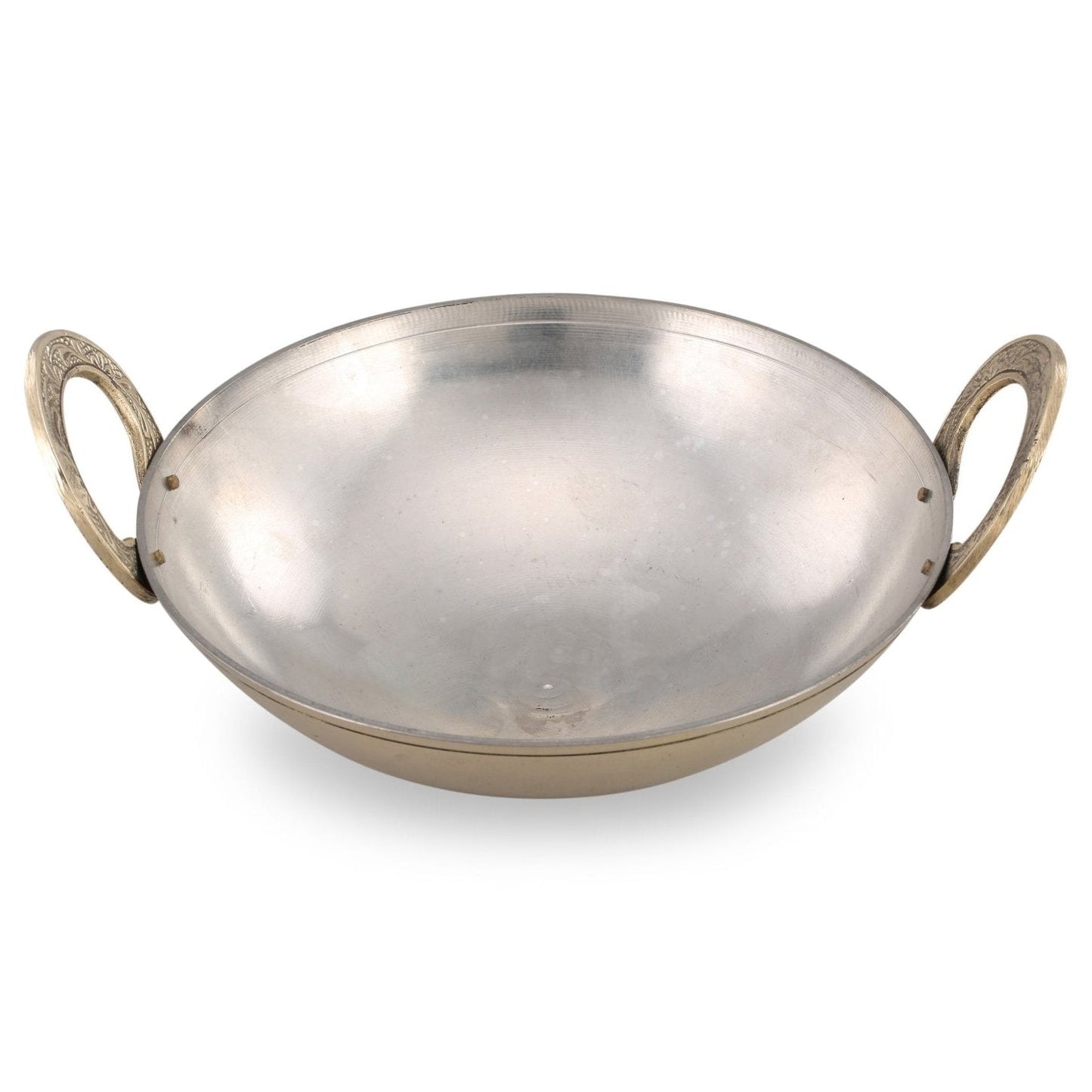SAMA Homes
Brass Kadhai with Tincoating
Brass Kadhai with Tincoating
51 in stock
Couldn't load pickup availability
- SAMA Homes Brass Kadhai with Tin Coating is highly durable.
- The taste and nutritional value of foods are preserved by the Kalai surface, which is safe for food contact.
- An essential Indian dinnerware for serving curries, daal, biryani, and condiments for an authentic Indian dining experience.
- Brass is still commonly used in so many towns and villages in the country. Cooking food in brass vessel increases strength add immunity.
-
Dimensions
a) 9inch 1kg
b) 10inch 1kg 430 gram
c) 11inch 2kg
d) 12inch 2kg 400 gram
e) 13inch 3kg 500 gram - Package content: 1 Kadhai with Tin Coating
-
Cooking in a brass kadhai releases natural oils, enhancing the flavor and taste of the food.
-
The presence of zinc in brass helps in purifying the blood, offering potential health benefits.
-
Pitambare powder is the traditional and best method for cleaning brass items, ensuring their longevity and luster.
-
Prepare authentic Indian dishes for your friends and family in this unique and ethnic-looking Brass Kadhai with Tin Coating, adding an extra touch of tradition to your culinary creations.
SKU:SH-BG_14
🥣 Chef's Tip: Cooking vs. Eating
Use Brass for cooking (to retain heat) and Kansa for eating (to alkalize food). Read the Ayurvedic Guide →
You Might Also Like in Ayurvedic Cookware | Authentic Copper & Brass Kitchenware – Sama Homes
Explore Related Categories
- Brand: View all SAMA Homes Products
- Category: See more Kadhais
- Collection: Browse all products
- Collection: Browse Ayurvedic Cookware | Authentic Copper & Brass Kitchenware – Sama Homes
- Collection: Browse Brass Cookware
- Collection: Browse Kitchenware
- Collection: Browse Sama Homes Kadhai and Frying Pans – Durable Brass, Stainless Steel and Cast Iron Cookware
- Collection: Browse Sama Homes Premium Brass & Copper Cookware – Durable, Handcrafted Kitchen Essentials
Browsing our catalog of 16,000+ authentic items. View Full Catalog.




Brass Utensils: A Sustainable Kitchen Choice
Brass, an alloy of copper and zinc, offers a surprisingly eco-friendly option for a variety of household items. Here's how brass contributes to a more sustainable lifestyle. Looking for ways to green your kitchen? Consider brass utensils! These beautiful and functional tools offer surprising sustainability benefits.
Collapsible content
Benefits of Brass Utensils
- Long-lasting Durability: Brass is a robust metal that can last for generations with proper care. Unlike disposable or flimsy utensils, brass stands the test of time, reducing waste and the need for frequent replacements.
- Reduced Landfill Impact: By choosing durable brass, you divert utensils from landfills, contributing to a cleaner environment.
- Natural Antibacterial Properties: Brass possesses inherent antibacterial properties, which can be beneficial, especially for frequently used cooking tools.
- Heat Conductivity: Brass conducts heat efficiently, ensuring even cooking and potentially reducing cooking times, which can save energy.
How Brass Utensils Reduce Your Carbon Footprint
- Lower Production Footprint: Compared to virgin materials, recycled brass requires less energy to produce, leading to lower greenhouse gas emissions.
- Less Waste, Less Transportation: Durable brass utensils minimize the need for frequent replacements, reducing waste generation and the environmental impact of transportation for new products.
- Multi-generational Use: Brass utensils can be passed down through families, further reducing the need for new production and its associated carbon footprint.
Sustainable Considerations
- Tin Lining: For acidic foods, choose tin-lined brass utensils. The lining protects food from reacting with the brass and prevents metallic taste. Unlined brass is best for dry goods or non-acidic foods.
- Proper Care: Handwashing and occasional polishing keep brass utensils looking their best and extend their lifespan, maximizing their sustainability value.
Embrace a Greener Kitchen
By incorporating brass utensils into your kitchen routine, you're not just adding a touch of elegance, you're making a conscious choice for a more sustainable future. So, ditch the disposables and embrace the beauty and longevity of brass!




